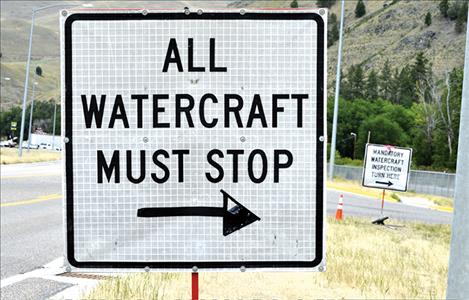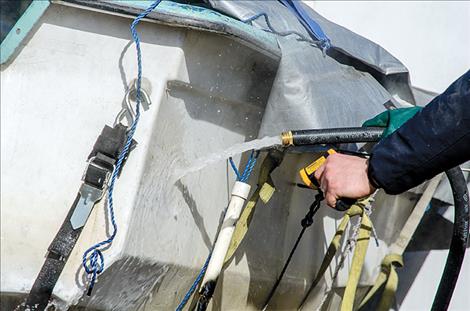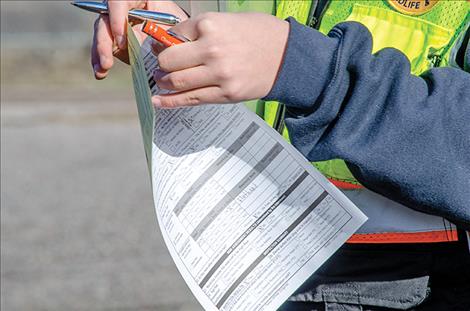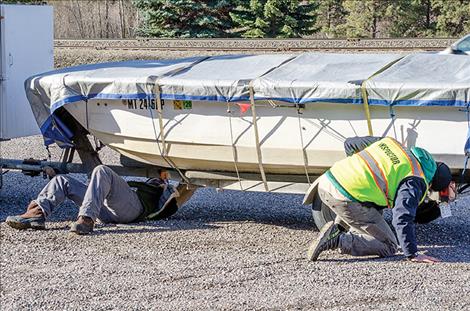Help protect Flathead Lake from aquatic invaders
Hey savvy news reader! Thanks for choosing local.
You are now reading
1 of 3 free articles.
LAKE COUNTY – Imagine a future where you are taking off your shoes and walking along the edge of the Flathead Lake during a warm summer day, looking out across the changing blue colors of the water, and suddenly, you feel a sharp pain in your foot.
Erik Hanson, the Confederated Salish and Kootenai Tribe’s Aquatic Invasive Species program coordinator, says that pain in your foot could be caused by a cut from the razor-sharp edge of a zebra or quagga mussel if those invasive species are able to establish in the lake. Tribal, state and local governments are working to prevent that from happening, but it only takes one contaminated boat to introduce the invaders into a body of water.
The issue becomes more urgent every year as the invaders spread further across the country. Invasive mussel larvae were found in Montana a few years ago when the Tiber Reservoir tested positive. Canyon Ferry Reservoir and Missouri River near Townsend both had water samples suspected of mussel larvae, but adult mussels haven’t been found in the state. According to the U.S. Fish and Wildlife Service, quagga and zebra mussels have been documented in more than 600 lakes and reservoirs in 30 states across the country.
If the mussels become established here, they could take away simple pleasures like walking along the shoreline with bare feet while creating more drastic impacts. The mussels could devastate food supplies for native species, create harmful algal blooms and alter water quality. Algal blooms are toxin-producing overgrowths of algae.
“It would change our way of life forever,” Hanson said. “Prevention is our only tool right now.”
Aquatic Invasive Species inspection stations are the biggest preventative tools currently being used across the state. Here on the Flathead Indian Reservation, CSKT and the state’s Fish, Wildlife and Parks Department have teamed up to provide an inspection station in Ravalli this year, which is now open 24 hours a day. Hanson was at the inspection station when it opened for the season in March. He crawled under boats and checked inside kayaks for any sign of AIS along with several other inspectors. The station will remain open through the summer.
Hanson said letting even one mussel get by could cause a problem because that one mussel could put millions of eggs into the water, and those eggs grow into larvae that attach to any hard surface including rocks, docks and dams.
According to FWP, both zebra and quagga mussels have byssal threads that allow them to attach to those hard surfaces, which are like little dangling strings until they attach to something. Montana does have some native mussels, but they are unable to attach to things.
The U.S. Geological Survey says the quagga and the zebra mussels are closely related, alike in appearance and have similar impacts to the environment. But the two species can be distinguished. When placed on a hard surface, the zebra mussel is stable with a flattened underside while quagga mussels lack a flat underside.
The zebra mussel is named for the striped pattern on its triangular shell much like the larger animal with the same name, although color patterns can vary to the point of having only a light or dark colored shell and no stripes. Zebra mussels are also more often found attached to hard surfaces including objects and other mussels.
Quagga mussels can colonize both soft and hard material including sandy lake bottoms and mud, according to FWP. Their color patterns vary widely from black, cream, or white bands. They often have dark rings on their rounded shells that get paler near the hinge. The quagga mussel was named after the extinct relative of the four-legged zebra.
Quagga and zebra mussels are filter feeders and can increase the transparency of the lake water they inhabit, which might seem like a nice side effect, but that water clarity increases light penetration, according to FWP. More light means more plants will grow and change the entire ecosystem. The mussels also produce waste as they filter the water, and that waste accumulates to create “a foul environment.” As those waste materials decompose, oxygen is used up and toxic byproducts released.
The mussels also create economic problems. As they colonize hard surfaces, they clog pipes and screens. CSKT notes that lakefront property along Flathead Lake is currently valued at $6 to $8 billion, and invasive mussels would cause a drop in property value of about $1.5 billion. It was also noted that the impact to tourism, hydropower, and infrastructure systems could be around $95 million a year if mussels get into the lake.
With the looming threat of invasive mussels, watercraft inspection stations and decontamination programs have been implemented in many states including Montana. Trained personnel inspect watercraft and equipment at different check stations. In 2015, Montana’s legislature authorized inspection stations with the Department of Transportation and the Department of Fish, Wildlife and Parks.
Anyone carrying or towing any watercraft or water-based equipment, non-motorized and motorized, must stop at all open watercraft inspection stations they encounter in Montana, according to FWP. If people fail to stop, local agencies including the Lake County Sheriff’s Office, FWP game wardens, Montana Highway Patrol, tribal officers and tribal conservation officers work together to respond to those calls and make sure watercraft are inspected.
Boating and watercraft regulations on the reservation state that all boats and watercraft need to stop at open inspection stations along their travel route. All boats and watercraft need a new inspection if they leave the Flathead Basin prior to launching into reservation waters.
Regulations also state that felt-soled waders are not permitted in any waters on the reservation and that all water gear and equipment must be clean and dry before use on any body of water.
In an effort to reduce the chance of contamination, people are asked to clean, drain and dry watercraft after leaving any body of water. Cleaning off plants, animals and mud reduces the chances of transporting an invasive species.
If mussels are found, the watercraft is expertly cleaned with high-pressure water to remove the mussels and 140 degree temperatures are used to kill the mussel after 10 seconds. Invasive mussels can live for as long as 30 days outside of water, depending on weather temperatures, so a decontamination time is also determined.
People traveling from outside the state can also volunteer to have their watercraft cleaned using the “hot wash” method to make sure none of the tiny larvae were brought into the state.
The Ravalli check station is open. Inspections can also be arranged by calling CSKT offices at 406 Sixth Ave. E. in Polson, Monday through Thursday, 7 a.m. to 5 p.m. Call 406-675-2700, ext. 7280 or 406-261-6515 to arrange a time.
For more information about Montana’s efforts to defend against aquatic invasive species, visit cleandraindrymt.com and the “Protect Our Waters Montana” Facebook page. For more information about the CSKT-AIS prevention program, visit CSKTnomussels.org.























